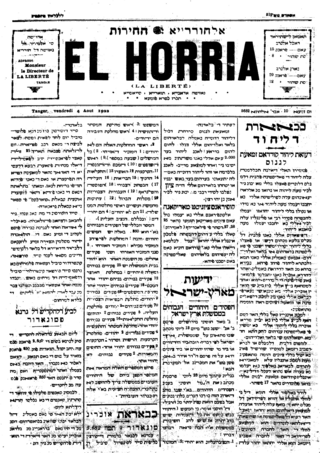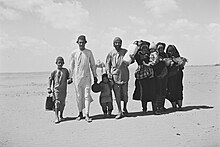In the 20th century, approximately 900,000 Jews migrated, fled, or were expelled from Muslim-majority countries throughout Africa and Asia. Primarily a consequence of the 1948 Arab–Israeli War, the mass movement mainly transpired from 1948 to the early 1970s, with one final exodus of Iranian Jews occurring shortly after the Islamic Revolution in 1979–1980. An estimated 650,000 (72%) of these Jews resettled in Israel.

Aliyah is the immigration of Jews from the diaspora to, historically, the geographical Land of Israel or the Palestine region, which is today chiefly represented by the State of Israel. Traditionally described as "the act of going up", moving to the Land of Israel or "making aliyah" is one of the most basic tenets of Zionism. The opposite action — emigration by Jews from the Land of Israel — is referred to in the Hebrew language as yerida. The Law of Return that was passed by the Israeli parliament in 1950 gives all diaspora Jews, as well as their children and grandchildren, the right to relocate to Israel and acquire Israeli citizenship on the basis of connecting to their Jewish identity.

Maghrebi Jews or North African Jews are ethnic Jews who had traditionally lived in the Maghreb region of North Africa under Arab rule during the Middle Ages. Established Jewish communities had existed in North Africa long before the arrival of Sephardi Jews, expelled from Portugal and Spain. The term Musta'arabi was also used by medieval Jewish authors to refer to Jews who had traditionally lived in the Maghreb. Due to proximity, the term 'Maghrebi Jews' sometimes refers to Egyptian Jews as well, even though there are important cultural differences between the history of Egyptian and Maghrebi Jews. These Jews originating from North Africa constitute the second largest Jewish diaspora group.
Yerida is emigration by Jews from the State of Israel. Yerida is the opposite of aliyah, which is immigration by Jews to Israel. Zionists are generally critical of the act of yerida and the term is somewhat derogatory. The emigration of non-Jewish Israelis is not included in the term.
Arab Jews is a term for Jews living in or originating from the Arab world. The term is politically contested, often by Zionists or by Jews with roots in the Arab world who prefer to be identified as Mizrahi Jews. Many left or were expelled from Arab countries in the decades following the founding of Israel in 1948, and took up residence in Israel, Western Europe, the United States and Latin America.

Moroccan Jews constitute an ancient community. Before the founding of the State of Israel in 1948, there were about 265,000 Jews in the country, which gave Morocco the largest Jewish community in the Muslim world, but by 2017 only 2,000 or so remain. Jews in Morocco, originally speakers of Berber languages, Judeo-Moroccan Arabic or Judaeo-Spanish, were the first in the country to adopt the French language in the mid-19th century, and unlike the Muslim population French remains the main language of members of the Jewish community there.
The Wadi Salib riots were a series of street demonstrations and acts of vandalism in the Wadi Salib neighborhood of Haifa, Israel, in 1959. They were sparked by the shooting of a Moroccan Jewish immigrant by police officers. Demonstrators accused the police of ethnic discrimination against Mizrahi Jews.
The First Aliyah, also known as the agriculture Aliyah, was a major wave of Jewish immigration (aliyah) to Ottoman Palestine between 1881 and 1903. Jews who migrated in this wave came mostly from Eastern Europe and from Yemen, stimulated by pogroms and violence against the Jewish communities in those areas. An estimated 25,000 Jews immigrated. Many of the European Jewish immigrants during the late 19th-early 20th century period gave up after a few months and went back to their country of origin, often suffering from hunger and disease.
This is a list of countries where antisemitic sentiment has been experienced.

Judeo-Moroccan Arabic is the variety or the varieties of the Moroccan vernacular Arabic spoken by Jews living or formerly living in Morocco. Historically, the majority of Moroccan Jews spoke Moroccan vernacular Arabic, or Darija, as their first language, even in Amazigh areas, which was facilitated by their literacy in Hebrew script. The Darija spoken by Moroccan Jews, which they referred to as al-‘arabiya diyalna as opposed to ‘arabiya diyal l-məslimīn, typically had distinct features, such as š>s and ž>z "lisping," some lexical borrowings from Hebrew, and in some regions Hispanic features from the migration of Sephardi Jews following the Alhambra Decree. The Jewish dialects of Darija spoken in different parts of Morocco had more in common with the local Moroccan Arabic dialects than they did with each other.
As an organized nationalist movement, Zionism is generally considered to have been founded by Theodor Herzl in 1897. However, the history of Zionism began earlier and is intertwined with Jewish history and Judaism. The organizations of Hovevei Zion, held as the forerunners of modern Zionist ideals, were responsible for the creation of 20 Jewish towns in Palestine between 1870 and 1897.

Moroccan Jews are Jews who live in or are from Morocco. Moroccan Jews constitute an ancient community dating to Roman times. Jews began immigrating to the region as early as 70 CE. They were later met by a second wave of migrants from the Iberian peninsula in the period which immediately preceded and followed the issuing of the 1492 Alhambra Decree, when Jews were expelled from Spain, and soon afterward, from Portugal. This second wave of immigrants changed Moroccan Jewry, which largely embraced the Andalusian Sephardic liturgy, to switch to a mostly Sephardic identity.

Anti-Jewish riots occurred on June 7–8, 1948, in the towns of Oujda and Jerada, in the French protectorate of Morocco in response to the 1948 Arab–Israeli War ensuing the declaration of the establishment of the State of Israel on May 14. The two towns—located near the border with Algeria—were departure points for Moroccan Jews seeking to migrate to Israel; at the time they were not permitted to do so from within Morocco. In the events, 47 Jews and one Frenchman were killed, many were injured, and property was damaged.
Operation Yakhin was an operation to secretly emigrate Moroccan Jews to Israel, conducted by Israel's Mossad between November 1961 and spring 1964. About 97,000 left for Israel by plane and ship from Casablanca and Tangier via France and Italy.
Egoz was a ship that carried Jewish emigrants from Morocco to Israel, at a time when the immigration of Moroccan Jews to Israel was illegal under Moroccan law. The ship operated undercover, and gained fame after sinking on 10 January 1961, which resulted in the loss of 46 lives, 44 of them immigrants.

The One Million Plan was a strategic plan for the immigration and absorption of one million Jews from Europe, the Middle East, and North Africa into Mandatory Palestine, within a timeframe of 18 months, in order to establish a state in that territory. After being voted on by the Jewish Agency for Palestine Executive in 1944, it became the official policy of the Zionist leadership. Implementation of a significant part of the One Million Plan took place following the establishment of the State of Israel in 1948.

Iraqi Jews in Israel, also known as the Bavlim, are immigrants and descendants of the immigrants of the Iraqi Jewish communities, who now reside within the state of Israel. They number around 450,000.
Moroccan Jews in Israel are immigrants and descendants of the immigrants of the Moroccan Jewish communities who now reside within the state of Israel. The 2019 Israeli census counts 472,800 Jews born in Morocco or with a Moroccan-born father, although according to the World Federation of Moroccan Jewry, nearly one million Israeli Jews are Moroccan or of Moroccan descent, making them the second-largest community in the country.

Turkish Jews in Israel are immigrants and descendants of the immigrants of the Turkish Jewish communities, who now reside within the State of Israel. They number around 100,000-150,000.

The history of the Jews in Paraguay has been characterised by migration of Jewish people, mainly from European countries, to the South American nation, and has resulted in the Jewish Paraguayan community numbering 1,000 today.













